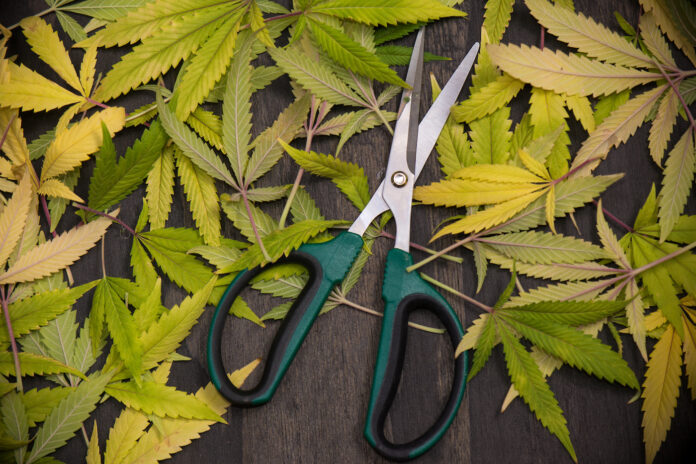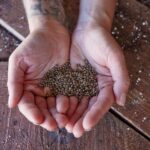No one stuck with a warehouse of unsold cannabis going into November wants to hear the Roman philosopher Seneca’s old adage that “luck is what happens when preparation meets opportunity.” But this irksome saying has endured for two millennia because it succeeds in reminding us to focus on what we can control—and, ideally, stop squandering precious time and energy on what lies beyond our influence.
As the outdoor season winds down, successful commercial farmers are already winterizing essential equipment, strengthening partnerships with retailers, evaluating staff performance, and analyzing data to optimize next year’s crop—all key components of a comprehensive off-season strategy. We connected with commercial cultivators from across the country to uncover expert insights on maximizing productivity during downtime and setting the stage for a profitable 2025. For growers ready to put in the effort, the off-season offers a new beginning and many hours of hard work.
Identify winning strains early
Whether developing new in-house genetics, leaning into the classics like OG Kush, Sour Diesel, and Blue Dream, or jumping on the hype train with Wedding Cake, Cereal Milk, and Garlic Cookies, genetics are the foundation for success. Growers who don’t make the right decisions many months before planting are setting themselves up for a disappointing year.
“Selecting next year’s genetics early is crucial for top cultivators to avoid supply issues,” said Benjamin Lind, co-owner and chief science officer at Humboldt Seed Company. “By identifying winning strains during the offseason, we shape the future of our breeding program. We track genetics from field to bag, focusing on our triploids and conducting fresh frozen flower tests for hash production, terpene content, and potency. Early data collection enables us to make fresh, unique varieties that the market desires.”
In addition to scouring the web for reliable lists of top-selling strains, cultivators should try to connect with a mix of industry data, point of sale, and ecommerce service providers serving relevant markets. Without a single reliable source of strain sales, there’s still a big blend of art and science in determining what’s likely to fly off the shelves next year.
“Genetics play a big role in what is successful in your location and localized climate,” said Tamara Kislak, owner of That Good Good Farm, a small family-owned and -operated craft cannabis operation deep in the hills of the Emerald Triangle. “We love weed in all its forms and love trying new stuff. Our grow is often a mix of our own seed stock, old favorites we’ve been keeping around as clones, and new stuff we try from friends and nurseries.”
Put the garden to bed
Farmers throughout history have prepared for future success by tending to the land in the off-season. Ancient Sumerians documented crop strategies in 1800 BCE, and the Egyptians used annual Nile flooding to enrich soil with nutrients. Today, cannabis cultivators can achieve similar results through cover crops and careful manure management, supporting sustainable yields season after season.
“To maintain soil health and avoid erosion, you’ve got to get that cover crop thriving,” said Kislak. “When that’s all done, the planning for next year begins.”
Soil studies have shown winter cover crops can alleviate the negative effects of seasonal freeze-thaw by promoting the accumulation of microbial biomass carbon and nitrogen. Winter cover crops such as rye, clover, legumes, and vetch can enhance nutrient cycling, reduce erosion, and improve ecosystem stability. However, determining the best winter cover crops will vary based on the climate, type of soil, and potential nutrient deficiencies.
If the local climate is especially harsh in the winter, manure can serve as an excellent alternative option for cannabis farmers. Adding a layer of cow, chicken, horse, goat, or sheep manure can help give the microorganisms in the soil a massive jump start in the spring with an ample supply of nitrogen, potassium, and phosphorus. Proper management is essential to prevent nutrient overload or contamination when working with manure.
Winterize equipment
“The midwest winters can be brutal outdoors and indoors, so the biggest thing here is winterization,” said Kurt Kinneman, director of cultivation at Superior Molecular. “Making sure all your irrigation lines are drained is very important to prevent lines from freezing and breaking. If you’re growing indoors, it’s also important to winterize any equipment exposed to the elements. That includes carefully checking to make sure window and door seals are in good condition to prevent drafts and cold spots in grow areas. This can be a great way to save money on heating costs.”
California cultivators may not be seasoned snow shovelers like their Midwest and Northeast counterparts, but in the remote hills of the Emerald Triangle, winter can deliver its own set of challenges with limited infrastructure, subfreezing temperatures, and soil erosion.
“In the California regulated market, we have a ton of requirements that need to be met for the water board regarding winterization of roads and cultivation areas,” said Kislak.
HVAC systems need preventive maintenance, including cleaning condenser coils and inspecting refrigerant levels. Heaters and dehumidifiers should also be inspected to maintain stable temperatures and humidity throughout winter downtime. Tools, vehicles, and outdoor equipment should be stored indoors or covered to prevent corrosion, with batteries and fluids checked to ensure they are ready for use in spring. Proper winterization protects investments, keeps operations efficient, and prepares cultivators for a strong start in the next cycle.
Review your calendar
Successful agricultural seasons begin with careful, strategic planning to refine processes and improve productivity. By January, outdoor growers should have a comprehensive calendar mapped out for the year. While predicting extreme weather like a cold spring or summer heatwave is impossible, planning ahead for multiple scenarios reduces the impact of adverse conditions and other known risks.
“We review our calendar where we’ve noted all our dates: soil amending, cloning, transplanting, tarping, and harvesting to see what went well and what didn’t,” said Kislak. “We see if there are improvements to processes that can be made to optimize the workflow. We stagger our greenhouses to ensure we have enough dry space for our harvests, but also to hedge against weather that may affect yield or quality.”
By using the calendar as a flexible guide, growers maintain operational agility. This approach encourages team members to remain mentally prepared, adjusting to emerging challenges and evolving conditions throughout the season. Regular check-ins help refine processes, ensuring optimal outcomes at every stage of cultivation.
Evaluate the team
Staffing decisions are among the most important and difficult decisions a leader can make.
“I believe team knowledge reviews in cultivation are essential,” said Liesl Bernard, founder and chief executive officer at industry staffing agency CannabizTeam. “They are an opportunity to not only check on the evolution of growing techniques and industry regulations but also to innovate from there. This ensures the cultivation team is ahead of the curve, leading to healthier cannabis plants and higher yields while maintaining and monitoring high standards and quality control.”
Some of the most important employee evaluations involve the mirror. The Harvard Business Review notes that 75 percent of cross-functional teams are dysfunctional. These teams consistently fail to meet planned budgets, stay on schedule, adhere to specifications, meet customer expectations, and align with company goals. Their dysfunction typically arises from ineffective governance, weak accountability structures, vague objectives, and the organization’s failure to prioritize the success of collaborative, cross-functional initiatives.
According to Harvard Professor Behnam Tabrizi, the difference between failure and success in these situations boils down to strong governance support. In Tabrizi’s study of 95 teams in 25 leading corporations, he found projects with strong governance support had a 76 percent success rate compared to 19 percent for projects with moderate support.
“Our research showed that the reason why most cross-functional teams fail is because siloes tend to perpetuate themselves: for example, engineers don’t work well with designers, and so on,” said Tabrizi. The solution is to establish a ‘portfolio governance team’ where high-level leaders make complex decisions on the various projects in their portfolio together. As they learn to work as a team, that attitude perpetuates itself in the teams under their purview.”
Strengthen relationships with retail partners
The cannabis industry employs nearly 450,000 people, but its roots in prohibition continue to shape it as a relationship-centric space. Personal connections, trust, and networking are still critical for driving projects forward and securing coveted spots on dispensary shelves, reflecting the industry’s reliance on strong partnerships amidst evolving regulations.
Strong relationships with dispensaries go beyond transactions. Building connections with budtenders and buyers helps ensure your products are top of mind. Research from Brightfield Group shows that budtenders influence more than half of in-store purchases.
For cultivators who aren’t vertically integrated, it’s important to consider the factors driving the best brick-and-mortar retailers in 2024. According to MIT Sloan Management Review, successful brick-and-mortar retailers focus on five core strategies that keep them competitive. They craft a unique value proposition to stand out in the market and create exceptional in-store experiences that build customer loyalty. They focus on providing seamless omnichannel integration to ensure customers can move between online and physical shopping with ease. Operational efficiency also plays a big role, helping cut costs while maintaining high service standards. Finally, adaptability keeps them ahead of the curve, allowing them to respond quickly to changing market trends and shifting customer preferences.
By finding ways to align with or support these goals—like providing well-written, original strain profiles with visually appealing photography formatted for the web—cultivators help dispensaries maintain a consistent and engaging customer experience across channels. Additionally, offering flexible delivery schedules and assisting with inventory forecasting ensures smooth operations and prevents product shortages. Collaborating on exclusive product launches or limited-edition drops can further strengthen the dispensary’s unique value proposition while creating buzz that drives traffic both online and in-store. Staying adaptive to market trends by experimenting with new strains or product formats also ensures that both the cultivator and retail partner remain relevant to shifting consumer preferences.
Final thoughts
The cultivation off-season doesn’t offer much downtime—it’s an opportunity to assess, plan, and prepare. From reviewing strains and strengthening retail partnerships to winterizing equipment and evaluating staff, each task plays a small but significant role in setting the stage for a profitable 2025. With thoughtful planning and intentional actions, growers can meet the challenges of the next season with confidence and momentum.











